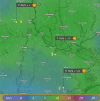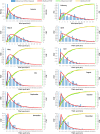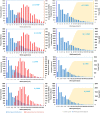Wind energy resource assessment and wind turbine selection analysis for sustainable energy production
- PMID: 38730007
- PMCID: PMC11087656
- DOI: 10.1038/s41598-024-61350-6
Wind energy resource assessment and wind turbine selection analysis for sustainable energy production
Abstract
The objective of this study is to perform an analysis to determine the most suitable type of wind turbine that can be installed at a specific location for electricity generation, using annual measurements of wind characteristics and meteorological parameters. Wind potential analysis has shown that the analyzed location is suitable for the development of a wind farm. The analysis was carried out for six different types of wind turbines, with a power ranging from 1.5 to 3.0 MW and a hub height set at 80 m. Wind power potential was assessed using the Weibull analysis. The values of the scale coefficient c were determined, and a large monthly variation was observed, with values ranging from 1.92 to 8.36 m/s and an annual value of 4.95 m/s. Monthly values for the shape coefficient k varied between 0.86 and 1.53, with an annual value of 1.07. Additionally, the capacity factor of the turbines was determined, ranging from 17.75 to 22.22%. The Vestas turbine, with a nominal power of 2 MW and a capacity factor of 22.22%, proved to be the most efficient wind turbine for the specific conditions of the location. The quantity of greenhouse gas emissions that will be reduced if this type of turbine is implemented was also calculated, considering the average CO2 emission intensity factor (kg CO2/kWh) of the national electricity system.
Keywords: CO2 emission avoided; Carbon dioxide; Renewable energy analysis; Sustainable energy production; Wind energy; Wind power density; Wind resource assessment.
© 2024. The Author(s).
Conflict of interest statement
The authors declare no competing interests.
Figures















References
-
- Paraschiv S, Paraschiv LS. Trends of carbon dioxide (CO2) emissions from fossil fuels combustion (coal, gas and oil) in the EU member states from 1960 to 2018. Energy Rep. 2020;6:237–242. doi: 10.1016/j.egyr.2020.11.116. - DOI
-
- Vallejo-Díaz A, Herrera-Moya I, Fernández-Bonilla A, Pereyra-Mariñez C. Wind energy potential assessment of selected locations at two major cities in the Dominican Republic, toward energy matrix decarbonization, with resilience approach. Therm. Sci. Eng. Progr. 2022;32:101313. doi: 10.1016/j.tsep.2022.101313. - DOI
-
- Harrucksteiner A, Thakur J, Franke K, Sensfuß F. A geospatial assessment of the techno-economic wind and solar potential of Mongolia. Sustain. Energy Technol. Assess. 2023;55:102889.
-
- Zhang Yi, Cheng C, Yang T, Jin X, Jia Z, Shen J, Xinyu Wu. Assessment of climate change impacts on the hydro-wind-solar energy supply system. Renew. Sustain. Energy Rev. 2022;162:112480. doi: 10.1016/j.rser.2022.112480. - DOI
-
- Şağbanşua L, Balo F. Multi-criteria decision making for 15 MW wind turbine selection. Proc. Comput. Sci. 2017;111:413–419. doi: 10.1016/j.procs.2017.06.042. - DOI
LinkOut - more resources
Full Text Sources

